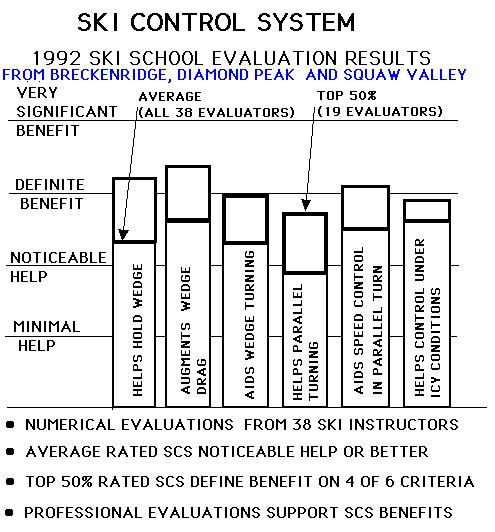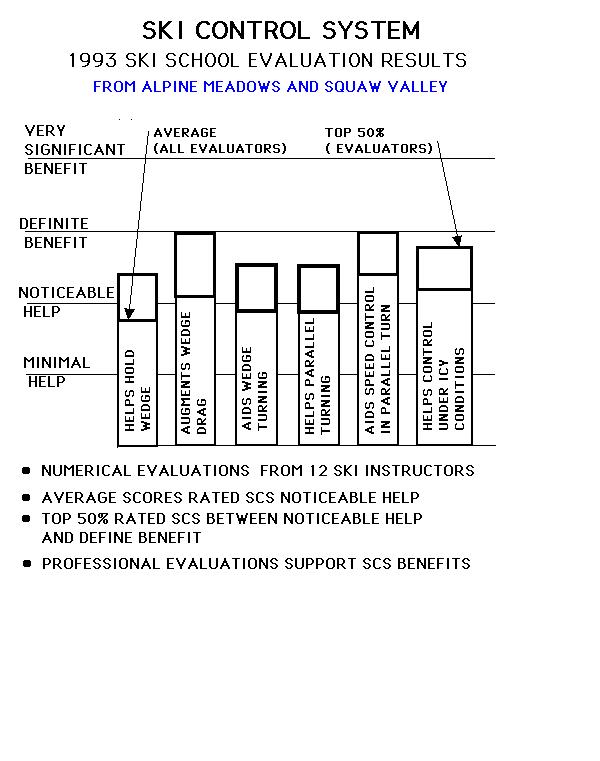
Humphrey Engineering supplied each ski school with one or more SCS equipped skis together with an SCS operations manual which thoroughly presented the design/operation of the SCS control probe and the anticipated control improvements expected. Instructors were funded for one hour each to ski with SCS equipped skis on beginning and low intermediate terrain.
Working with the participating ski schools Humphrey Engineering developed an SCS Evaluation Form that was used consistently by all ski instructors to report their evaluations. The evaluation form consisted of two pages. A sample evaluation from Mr. Dave Smith of Squaw Valley dated 2/28/92 is presented for your review.
On the first page Dave presented his evaluation of the enhanced control provided by the SCS in five of the six requested aspects of both wedge and parallel sking (there were no icy conditions for Dave to evaluate). The numerical ratings (shown in the legend on the second page below) were
1 = Minimal Help
2= Noticeable Help
3= Definite Benefit
4= Very Significant Benefit
Dave rated the SCS a Noticeable Help for helping to hold a wedge. The wedge is an awkward position especially for new skiers. When the skis are in a wedge position, the SCS probes provide a torque that helps the skier maintain the wedge with less muscle strain.
Dave rated the SCS a Definite Benefit for augmenting edge drag in a wedge. New skiers often have a relatively flat wedge because they haven't developed the muscle control to rotate their ankles to edge their skis in a wedge position. Without ski rotation a flat wedge is ineffective in providing drag needed to control speed. However the SCS probes are streamlined but outwardly canted at 20 degrees. Therefore even a flat wedge (i.e. ski flat to the snow, but tips pointed together) angles the probes into the snow and provides a noticeable and beneficial increase in drag to help the skier control speed. As the skier learns to rotate the ski, this rotation digs the probes deeper into the snow further enhancing SCS speed control in a wedge.
Dave rated the SCS a Very Significant Benefit for aiding wedge turning. When a skier puts more of his/her weight on one ski in a wedge, both the edge force and the SCS probe force on that more heavily weighted ski are greater than the corresponding forces on the opposite ski. Since both the SCS probe and the center of pressure of the ski in this wedge position are slightly forward of the skier's center of gravity, these forces create a torque that turns the skier toward the less heavily weighted ski. Therefore the SCS probe force works with the edge force to provide enhanced turning ability in a wedge.
Dave rated the SCS a Definite Benefit for helping initiate and complete a parallel turn. When a skier in a straight run rotates his/her ankles to one side bringing the ski on edge, the skis naturally form an arc and then follow that arc in a turn. With SCS control probes installed on the ski, rotating the ski on edge extracts the outside probes on both skis from the snow so that the drag of the inside probes create a torque that aids the carve of the ski in making the turn. Since new parallel skiers are often timid in edging their skis, the additional torque of the SCS probes can be quite helpful in providing effective turning. This more effective turning can help these skiers transition to parallel skiing.
Dave rated the SCS a Definite Benefit for aiding speed control through a turn. In a coordinated parallel turn there is very little loss of speed because the track of the ski follows its natural arc just like a railroad train going around a curve. Downhill racers use this phenomenon of skiing to maintain high speeds on their run. However recreational skiers often seek to achieve drag in a turn to keep their speed under control. In a coordinated turn the inside SCS probe provides both torque to augment the turn and drag to reduce speed through the turn. Skidding the ski through a parallel turn is an effective way to increase drag and the SCS probes also provide additional drag in a skidded turn.
Dave did not have the opportunity to rate SCS performance under icy conditions. However other instructors did and their results reported later in the summary rated the SCS a definite benefit. Under hard snow conditions the sharp SCS probes penetrate the snow much like a keel on a sailboat. They provide both an edge to reduce the tendency of the skis to slip sideways and they also provide a point load that acts like a pivot to help skiers turn under icy conditions.
On the second page of the evaluation form Dave presented his assessment of four SCS operational features. While our goal is to continue refining the SCS, Dave felt that the probe engagement/disengagement operations, the flat ski drag and the ability to ride and exit a chair lift keeping the probe engaged were all satisfactory.
Dave also provides very valuable written comments: " Did give reference point underfoot to pivot on. Gave more feeling of going slower that actually slowed down. (Felt like training wheels but didn't drag too much.) Was good in wedge turns to reduce skidding as much. Also could feel vibration under foot so was good for stance reference. Liked it in Wedge Christy I & II a little more than in parallel because of pivot point and drag. Also was okay on slightly steeper without causing too much more drag. Overall not bad
1992 Formal Ski Instructor SCS Numerical evaluations (using the same form presented for Dave Smith above) were received from 38 instructors at Breckenridge, Diamond Peak and Squaw Valley. These results are summarized in the graphical presentation below.

The average for all 38 instructors rated the SCS a noticeable help or better on 5 of the 6 categories while the ratings of the top 50% ( 19 ski instructors) rated the the SCS a definite benefit on 4 of the 6 categories. We also received written evaluations from ski instructors who field tested SCS equipped skis at Alpine Meadows ski school and Heavenly ski school. The excellent results from these geographically and professionally broadbased professional evaluations provided strong support for public access to SCS equipped skis via the beginning lesson program which began during the 1993 ski season.
While the beginning student lessons at Heavenly received our primary attention during the 1993 ski season, there was also a smaller scale instructor evaluation program. The objectives of that program were to further support the 1992 base of instructor evaluations and hopefully encourage some of these resorts to follow Heavenly's lead in providing public access to SCS technology via beginning ski lessons with SCS equipped skis. Numerical evaluations using the same 1992 evaluation form presented above were received from 12 ski instructors from the Alpine Meadows and Squaw Valley ski schools. As shown below these results supported the 1992 evaluations and increased the total number of formal ski instructor evaluations to 50 for the 1992 and 1993 ski seasons and the number of ski schools providing formal ski instructor evaluations to five (Alpine Meadows, Breckenridge, Diamond Peak, Heavenly and Squaw Valley).

While the very supportive instructor evaluations of SCS benefits was sincerely appreciated, the overwhelming supportive comments from students taking beginning ski lessons on SCS equipped skis has been exceptionally gratifying. Please review these student comments from the other links on the Student Comment and Instructor Evaluation Index page.
OR